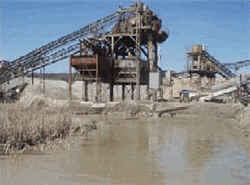Mineral Mining and Processing Effluent Guidelines
 EPA promulgated the Mineral Mining and Processing Effluent Guidelines and Standards (40 CFR Part 436) in 1975, and amended the regulation in 1976, 1977, 1978, and 1979. The regulation covers wastewater discharges from mine drainage, mineral processing operations and stormwater runoff. The Mineral Mining regulatory requirements are incorporated into NPDES permits.
EPA promulgated the Mineral Mining and Processing Effluent Guidelines and Standards (40 CFR Part 436) in 1975, and amended the regulation in 1976, 1977, 1978, and 1979. The regulation covers wastewater discharges from mine drainage, mineral processing operations and stormwater runoff. The Mineral Mining regulatory requirements are incorporated into NPDES permits.
On this page:
What is Mineral Mining?
Mine operators extract minerals from underground mines, surface mines and quarries using machinery and explosives. Some extraction processes, such as stone quarries, may use large quantities of water. After extraction, many types of raw minerals are then subject to processes such as crushing, milling, washing and chemical treatments.
Wastewater is generated during mineral processing (e.g., stone cutting, wash water, scrubber water), from equipment cooling, from mine dewatering, and from stormwater runoff at mines and processing plants.
Note: Hard rock mining of metals (ores) is covered in the Ore Mining Effluent Guidelines, 40 CFR Part 440.
Facilities Covered
The Mineral Mining and Processing effluent guidelines apply to wastewater discharges from facilities in 21 subcategories covering extraction of a wide variety of minerals. Examples, with their corresponding NAICS codes, are:
- construction materials (e.g., stone, gypsum, asphalt, sand & gravel); NAICS 21231, 212319, 212321, 212399.
- minerals used in the chemical & fertilizer industries (e.g., borax, potash, magnesium, phosphate); NAICS 212391, 212325, 212392.
- miscellaneous minerals (e.g., barite, bentonite, graphite); NAICS 212393, 212325, 212399.
Note: the NAICS group listing is provided as a guide and does not define the coverage of the Mineral Mining regulations. For a complete list of mining processes and precise definitions of coverage, see the applicability sections in 40 CFR Part 436.
Subcategories
- Crushed Stone
- Construction Sand and Gravel
- Industrial Sand
- Gypsum
- Asphaltic Mineral
- Asbestos and Wollastonite
- Barite
- Fluorspar
- Salines From Brine Lakes
- Borax
- Potash
- Sodium Sulfate
- Phosphate Rock
- Frasch Sulfur
- Bentonite
- Magnesite
- Diatomite
- Jade
- Novaculite
- Tripoli
- Graphite
Rulemaking History
1979 Amendment
Revocations of selected BPT provisions, pursuant to litigation: Subparts B, C
- Documents, including:
- Final Rule (December 28, 1979)
- Development Document
This publication includes technical documentation for the 1979, 1976 and 1975 final rules, and the basis for draft limitations in additional subcategories. It describes industry processes, subcategories, pollutants generated, available control and treatment technologies, the technical basis for the rules, and costs of the rules.
1978 Amendment
Established NSPS requirements: Subpart R
- Documents, including:
- Final Rule (March 10, 1978)(BAT & PSNS proposals withdrawn)
- Proposed Rule (June 10, 1976)(BAT, PSNS & NSPS)
1977 Amendment
Revised BPT requirements: Subparts B, C, D, R
- Final Rule (July 12, 1977)
1976 Amendment
Established BPT requirements: Subparts B, C, D, R
- Documents, including:
- Interim Final Rule (June 10, 1976)
- Development Document
1975 Initial Rulemaking
Established BPT requirements: Subparts E, F, G, J, K, L, M, N, O, S, V, W, X, Y, Z, AF, AL
- Documents, including:
- Interim Final Rule (October 16, 1975)
- Development Document
Additional Information
For additional information regarding Mineral Mining and Processing Effluent Guidelines, please contact Steve Whitlock (whitlock.steve@epa.gov) or 202-566-1541.
